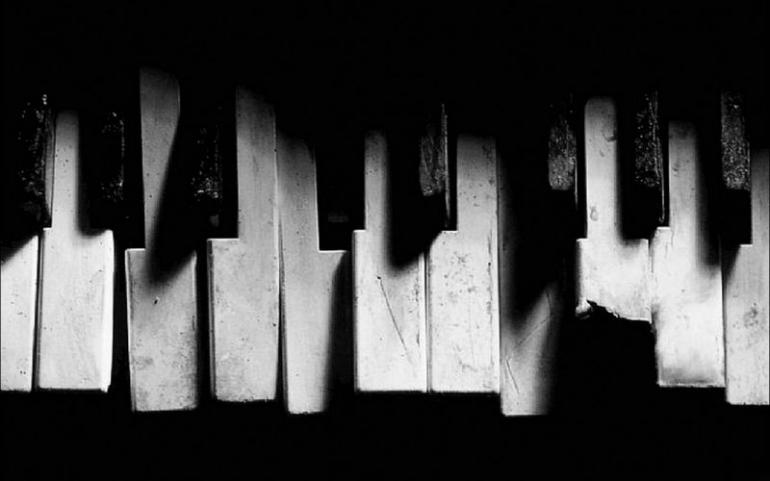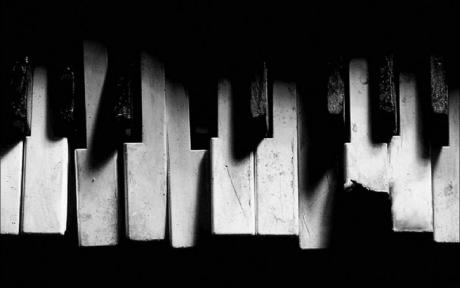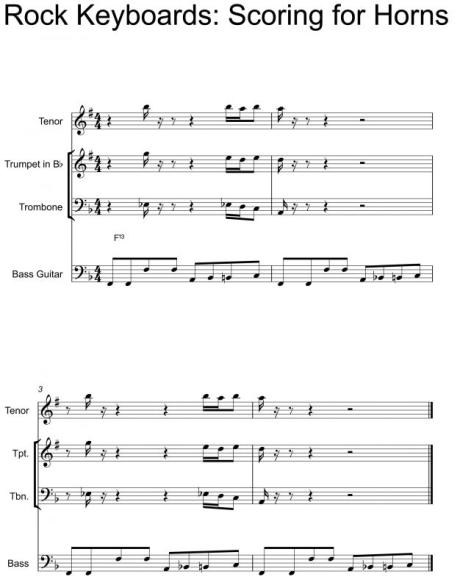Rockové klávesy - Scoring for Horns/Zápis dechových nástrojů do not
Welcome, readers, to another installment of Rock Keyboards! This month I wanted to give you a few tips to add some brass and winds to your band’s sound. The main challenge in horn writing is that some of them are transposing instruments. This means that they are written at a different pitch than the one they sound on. Our horn section for this example with be a very common one; trumpet, tenor sax, and trombone.

Trombone is written as it sounds with no transposition. Trumpet is written a major 2nd above where it sounds and tenor sax which is written a minor 9th higher. On your own you should do a little research about the ranges of the different instruments because it's very common for beginning arrangers to write out of the range of an instrument. There are also horn specific notations, like accents and sforzandos that you should investigate. This little tutorial will get you started, though.
Modern music software
Most modern music notation software is really great when it comes to transposing instruments. On the program I use, Sibelius, I can write in piano score, click a button, and the chart is automatically transposed to the correct written parts for the Bb instruments. Let’s take a look at our score. Let’s say we are playing over a F7 funk vamp in the style of James Brown. I’ve enclosed a simple bass line so you can see how the rhythm is developing. Our horn section is made up of trumpet, tenor sax, and trombone. The great thing about playing keyboards is that you can assign a horn instrument to each of the notes in your chords you would normally play to come up with pretty cool horn riffs.
The parts
The trumpet part is the highest voice. Here it is grouped with the trombone because they are both brass instruments. The tenor has the inner voice and the trombone the lowest. The trumpet is written up a major 2nd, the tenor up a major 9th. Even though the tenor part looks higher than the trumpet, it actually sounds lower. Bar 3 has the same horn part starting on an offbeat hit. The trumpet starts on a high tonic note then goes between the 6th and 5th of the chord. The tenor hovers around the third of the chord to fill in the harmony. The trombone uses the 7th scale degree. Another great technique for horn writing is called drop 2. This is when you take the second note from the top, in this case the tenor sax, and move it to the bottom of the section. Remember, the tenor and trumpet parts are written in G even though they sound in F. Experienced arrangers can transpose in their heads!
Try these exercises in your own band. If you have a tune that is lacking a little power, try adding a few horns! Again, this is just an introduction to horn writing which is a very involved subject when done at a high level. On your own, I highly suggest studying online to gain further insight.

Sforazndo: Z italského sforzo, což znamená „usilovat“ či „vynaložit úsilí“. Jedná se o specifický druh hudebního důrazu, přízvuku. Často se můžeme setkat s víceméně ekvivalentním výrazem sforzato. Značí se sf nebo sfz. Čím se ale liší od „obyčejného“ akcentu? Odpovědi na tuto otázku se různí a do určité míry vycházejí z nástroje, kterého se v daném případě pojem týká. U klavíru se zjednodušeně řečeno jedná o velmi silný důraz. V tomto článku však Brian hovoří o žestích, kde je určující nejen síla přízvuku, ale také to, co přijde bezprostředně po něm. Na rozdíl od klavíru můžeme u dechových (i smyčcových) nástrojů tón začít velmi silně a ihned poté ubrat na intenzitě, aniž bychom daný tón přestali hrát. Následně jej opět, tentokrát pozvolna, zesilujeme. U žesťových sekcí je tento výrazový prostředek poměrně populární a může být velmi expresivní.
Bb instruments: Transponující nástroje, u kterých když v notovém zápisu čteme notu C, zní ve skutečnosti B (resp. v angličtině B-flat neboli Bb). Patří sem především žesťové nástroje, jako trumpety a pozouny.
Offbeat hit: Jako velká část pojmů má i slovo „hit“ více významů, které závisejí na kontextu. U orchestrálních sekcí jde o jistý druh akcentu, kdy zpravidla celý orchestr či sekce zahraje silný tón hraný staccato (resp. spíše souzvuk). Tato technika dodá skladbě dramatický efekt. Jedná se o pojem příbuzný slovu „stab“, který se používá především u dechových sekcí. Pojem „offbeat“, tedy „lehká“ či nepřízvučná doba, pravděpodobně znáte...
The tenor hovers around the third: „Hover“ znamená vznášet se či poletovat. V tomto případě bychom tedy mohli frázi volně přeložit jako „tenor se motá (pohybuje) kolem tercie“. Brian tím naznačuje, že se nejedná o hlas, ve kterém je mnoho pohybu. Od tercie se nikdy na dlouho nevzdálí...




